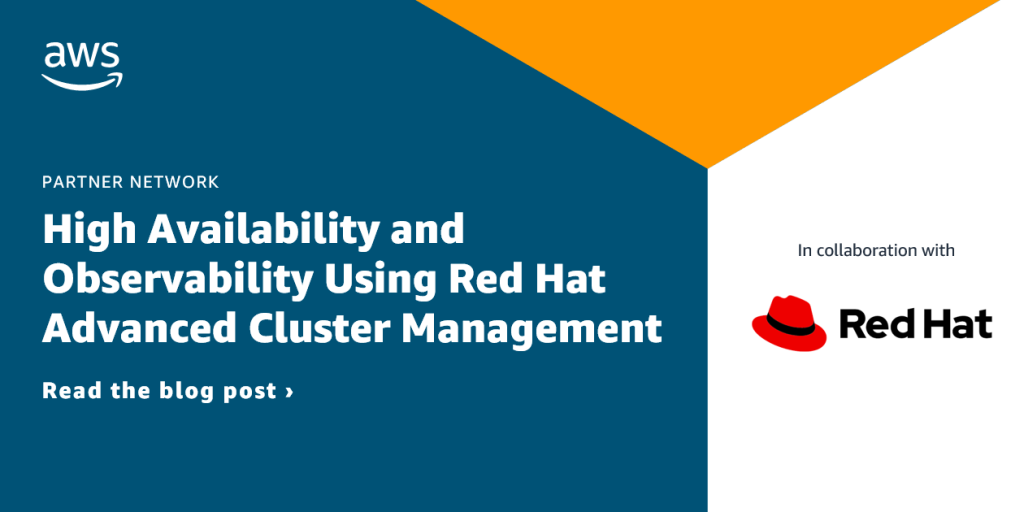AWS Partner Network (APN) Blog
Tag: Red Hat
Enhanced Threat Detection with AWS Security Hub and Red Hat Advanced Cluster Security for Kubernetes
AWS customers can run Kubernetes on managed services like Amazon EKS or self-managed options. To secure these environments, Red Hat Advanced Cluster Security for Kubernetes (RHACS) detects vulnerabilities and policy violations. Its findings can be sent to AWS Security Hub which aggregates security issues across AWS services. This post walks through installing RHACS on Red Hat OpenShift Service on AWS, creating policies in RHACS, and integrating with Security Hub to view findings.
Migrating SAP HANA to AWS Faster with Red Hat Ansible Automation Platform
For SAP customers aiming to cut costs, a popular option is replatforming to the AWS cloud, which can be done seamlessly using various migration tools and methodologies. Customers can migrate SAP HANA from on-premises environments to AWS using the Red Hat Ansible Automation Platform. This solution offers a fast, user-friendly migration with expert guidance along the way. Red Hat provides added security, reporting, analytics, and technical support to help organizations scale their automation programs.
Leapfrog from CentOS 7.9 to Red Hat Enterprise Linux 8.9 with Convert2RHEL and Leapp Utilities on AWS
While implementing a new OS may seem tedious, it presents an opportunity to reassess your organization’s needs, and this overview discusses key benefits of migrating to Red Hat Enterprise Linux from CentOS Linux. The ‘convert2rhel’ utility converts a CentOS 7.9 or CentOS 8 instances in-place to RHEL 7.9 or RHEL 8 instance. The Leapp utility converts the RHEL 7.9 instance to a RHEL 8.9, and Red Hat publishes lifecycle dates for RHEL. Note that RHEL 8 will continue to receive updates until May 31, 2029.
Start Your Learning Journey with the Right Roadmap from AWS Training and Certification
To help break down barriers and develop your cloud skills, Amazon Web Services (AWS) has created several methods to guide you on the correct learning journey, including learning plans, courses with different training styles, and a curated list of our most popular courses amongst AWS Partners. In this post, explore what training resonates with the thousands of partners already learning with AWS Partner Training and Certification.
Benefits of Running Virtual Machines on Red Hat OpenShift for AWS Customers
Virtual machines remain a crucial part of many IT environments due to the long-term and substantial investments made by companies. Experts from IBM Consulting and AWS share how running VMs on top of Red Hat OpenShift Container Platform on AWS offers several benefits, including integrated management, migration and modernization, and improving developer productivity. Red Hat OpenShift Virtualization is an enterprise-grade feature that makes it easy to deploy and manage VMs on OpenShift.
Orchestrating Multi-Region Apps with Red Hat Advanced Cluster Management and Submariner
Customers have different reasons to run multiple Red Hat OpenShift clusters, including having separate clusters per geographical locations, setting a cluster-level boundary between mission-critical applications, data residency, and reducing latency for end users. This post explores Red Hat Advanced Cluster Management for Kubernetes and how it extends the value of Red Hat OpenShift for hybrid environments. It also explores different scenarios where having a multi-cluster environment is beneficial.
High Availability and Observability Using Red Hat Advanced Cluster Management for Kubernetes
As container usage increases in application modernization efforts, Kubernetes plays an important role in managing container-based applications. Managing these multi-cluster life cycle, application deployments, and enforcing security policies across clusters is often challenging and time consuming. Learn how Red Hat Advanced Cluster Management for Kubernetes (RH ACM) addresses the challenges associated with managing multiple clusters and meets the requirements of multiple personas.
Say Hello to 125 New AWS Competency, Service Delivery, Service Ready, and MSP Partners Added in November
We are excited to highlight 125 AWS Partners that received new designations in November for our global AWS Competency, AWS Managed Service Provider (MSP), AWS Service Delivery, and AWS Service Ready programs. These designations span workload, solution, and industry, and help AWS customers identify top AWS Partners that can deliver on core business objectives. AWS Partners are focused on your success, helping customers take full advantage of the business benefits AWS has to offer.
Introducing the AWS Graviton Ready Program for Graviton-Enabled Software Products
AWS Graviton processors are custom-built to enable the best price performance for workloads in Amazon EC2. As customers adopt AWS Graviton-based EC2 instances, they need the right software solutions to help integrate, deploy, monitor, and secure their Linux-based and containerized workloads. We are excited to announce the new AWS Graviton Ready Program, part of the AWS Service Ready Program which validates software products built by AWS Partners that integrate with specific services such as AWS Graviton.
How to Use Webhooks to Automate Red Hat OpenShift App Rebuilds from AWS CodeCommit
One of the offerings to help joint AWS and Red Hat customers build for an open hybrid cloud future is Red Hat OpenShift Service on AWS (ROSA), a fully managed OpenShift service, jointly supported by both Red Hat and AWS. In this post, we focus on a single but common use case often observed in the field where a joint enterprise customer has made investments in the AWS Cloud and is now considering expanding and adopting ROSA service as part of the AWS portfolio.









